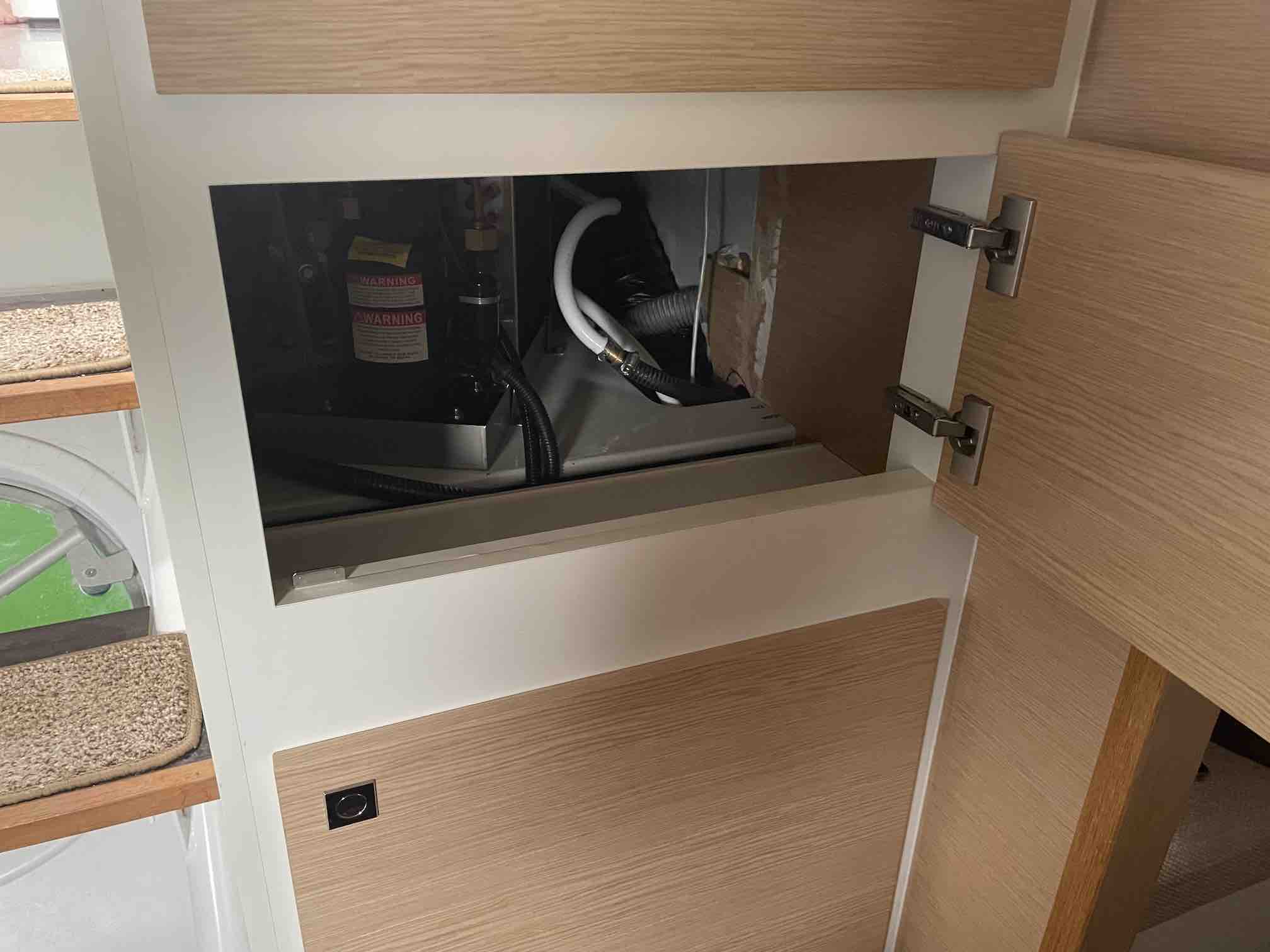Heater Install
The Problem
Our plans involve a fair bit of northwest sailing before we head south to warmer climes. To make the most of spring, we decided to add a heater to the boat.
Options
For heat, our options are either forced air or hydronic diesel heaters. If all we wanted was a heater, the ideal and most efficient system is a properly sized hydronic system. Hydronic heaters sip a bit of diesel to heat up a recirculating a loop of glycol. The glycol runs to small heat exchangers distributed through out the boat, each with a fan to blow warm air into all of the places you want heat. You get the heat exactly where you want it, with minimal heat loss.
For our boat we would need somewhere in the neighborhood of 45k btu of heat to make every part of the boat warm. We used SureMarine.com recommended calculations for a boat of our volume. However, Outremer usually equips the boat with a single forced air 26k btu Webasto Thermo Pro 90 unit. Other Outremer owners have said that the 26k btu unit is plenty for comfortable cruising in Northeast United states winter. It is possible that the foam core provides enough insulation to make that appropriately sized, I suspect it might be a touch undersized. If you get a cold snap from time to time or even do the occasional cruise to colder places, that’s probably enough. For full-time cold weather, I suspect ta 26k btu unit will be working harder than it should and won’t last as long as a larger unit.
Hydronic has a lot of nice features. You can heat the loops from three sources. You can heat the loop with the diesel heater unit of your choice. You can also heat the loop off of engine waste heat from running engines. Finally, you can use the electric water heater to heat the loop. The heat transfer goes both ways, so you can also heat the water tank with engine heat or the diesel heater. Having hot water at anchor is an appealing option even once we are down in the tropics.
The not so nice part about hydronic is that the installation is complex. You must deal with electric wiring to various pumps, the heater, and the fan units all over the boat. You have to plumb diesel to the heater. You have to plumb the cooling loop all over the boat. The estimated install time for a professional is 120 hours. Hydronic was our first pick, but we were unable to find someone to install the unit for us. It would have taken me 3 years to complete the project myself, so we needed alternatives.
Forced air diesel is another option, one that Zephyr, a Danson Outremer 55 recommends . Zephyr have done a few months of high-latitude cruising and had nothing but good things to say about Wallas units. The installation of forced air diesel heaters is a bit simpler than hydronic. You still have to deal with plumbing diesel and electricity to the heater unit. For the heater outlets, instead of running electrical wires and heat loop plumbing, you have to run insulated ducting wherever you want the heat. With a forced air unit, you don’t get hot water, so once we get to the tropics, any forced air system is just take up space and weight.
The third option we considered was reverse cycle air conditioner. These are heat pumps that can either cool the boat or they can run in reverse to heat the boat. They generally require a lot of electric power to run a compressor, a seawater pump to cool the compressor coils, and a central fan to force heated or cooled air through the boat.
Initially I didn’t think this was a viable option. Most reverse cycle A/C units use a lot of 120VAC, something north of 1,200 watts, sometimes quite a bit more than that. Most units are designed to run off of a generator, which Spice does not have. However, I found a high-efficiency 12VDC air conditioner by Mabru. Mabru offers a 12k btu unit that uses less than 600 watts of DC power for around $5,000 USD. 12k btu was less than half of the 26k btu Outremer normally installs on a boat of our type, but we planned to close off the heated / cooled space to just the salon and master cabin to compensate. Installation was similar in complexity to forced air diesel. The main differences being that we’d need to plumb sea water through the boat instead of diesel. Plumbing seawater is preferable to plumbing diesel. We also had to feed 60 amps of 12VDC power to the unit, requiring a new direct run of large 4AWG cable.
The Mabru unit was ~25% more expensive than the Wallas forced air diesel of similar btu output, but was much cheaper than the hydronic solution, which would have cost us $30,000 USD or more with professional installation. Air conditioning makes the tropics a bit less humid and a little cooler and was a selling point for the reverse cycle option. I also liked that we could power the unit with electricity without burning diesel. When the sun is blazing, our ~2,400 watts of solar should be more than enough to feed the beast. We even have enough battery capacity to run the unit for ~19 hours. Those numbers might work for the tropics, but we would be on a very tight power budget for any northwest sailing, where cold temperatures coincide with very little sunlight for solar power. Even with that compromise, this seemed like the best option and is ultimately what we decided to purchase.
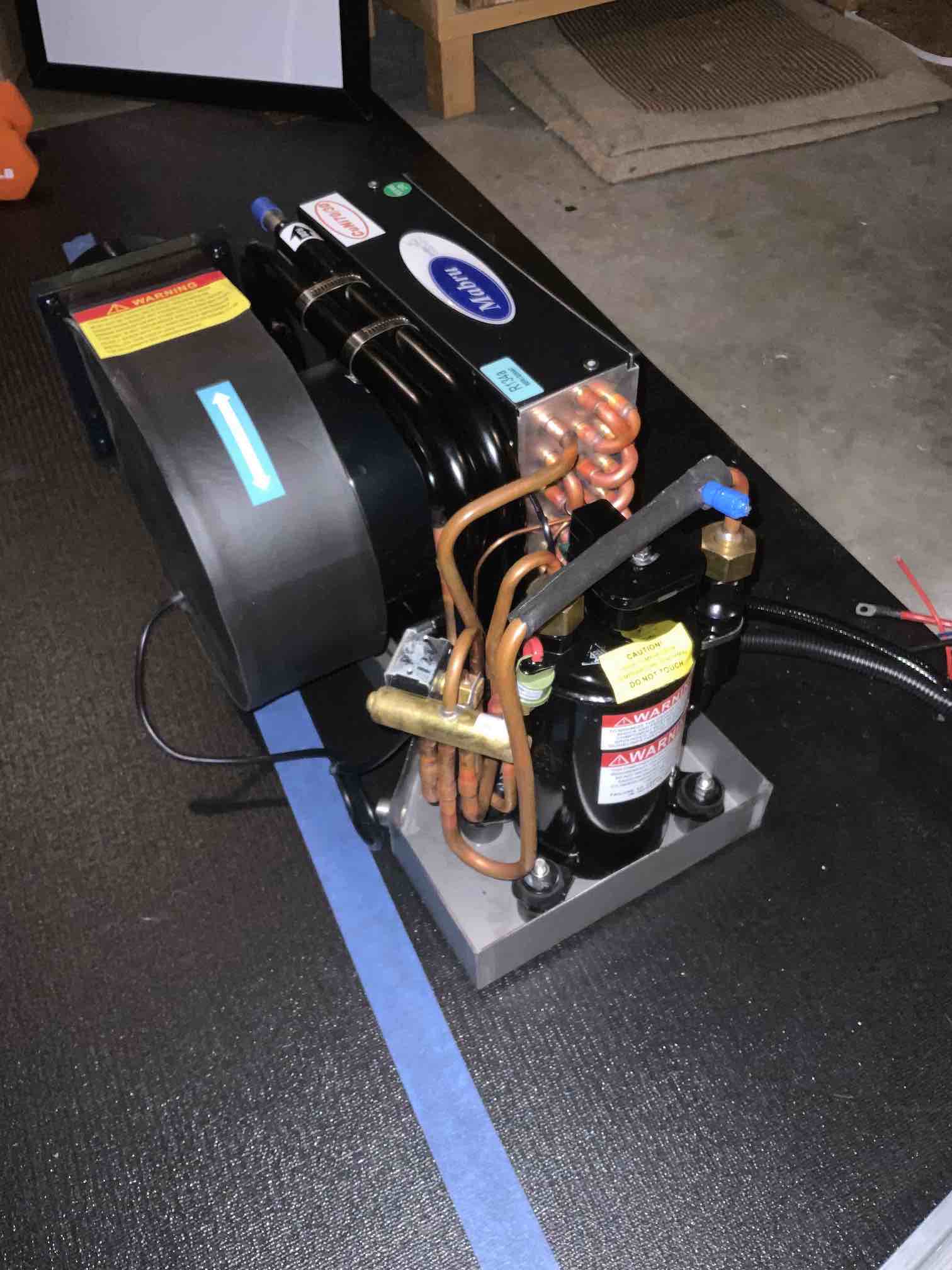
Installation Planning
Reverse cycle AC units must not be installed in the bilge, or a least, bilge air should not get into the air intake of the unit for two reasons. First, the bilge air will always be cold, and pulling in bilge air means the unit will have to work harder to heat the boat. Second, the bilge can get moldy or can accumulate fumes that shouldn’t be pumped around the breathable airspace of the boat. I wanted to place the unit close to the main battery bank to minimize the power run, and close to the master cabin and salon to keep the ducting runs short. The options where under the bed of the master cabin or under the bench seats in the salon. The latter was unappealing, because I would have to run seawater and condensate plumbing through our main electric raceways. Leaks would be very problematic. Water and high-amperage electricity don’t mix. Installing under the bed seemed ideal and straight forward. The only downside was losing prime storage space.
I spent time looking for alternative locations. Sniffed out all of the other possible hidey holes and plenums throughout the boat. I found a space behind cabinetry and under our freezer that looked like it might work. The problem was the space was right at the bridge deck joint to the port hull, which meant I’d need to build a shelf on awkward angles to mount the air conditioner. I would also have to make significant modifications to the cabinets and shelves. Finally, the space looked like it would fit the unit, but only just. I decided this hidey hole was the ideal place to install, despite the significant increase in complexity. I didn’t want to lose storage space. There was another benefit. Because the AC unit was above the bridge deck, I could reuse through hulls use by the cockpit scuppers that were already drilled into the boat. Installing under the bed meant drilling new holes in the hull, and installing a new sump pump to evacuate condensate build up. I wasn’t keen to drills holes, but I was willing to do the cabinet work.
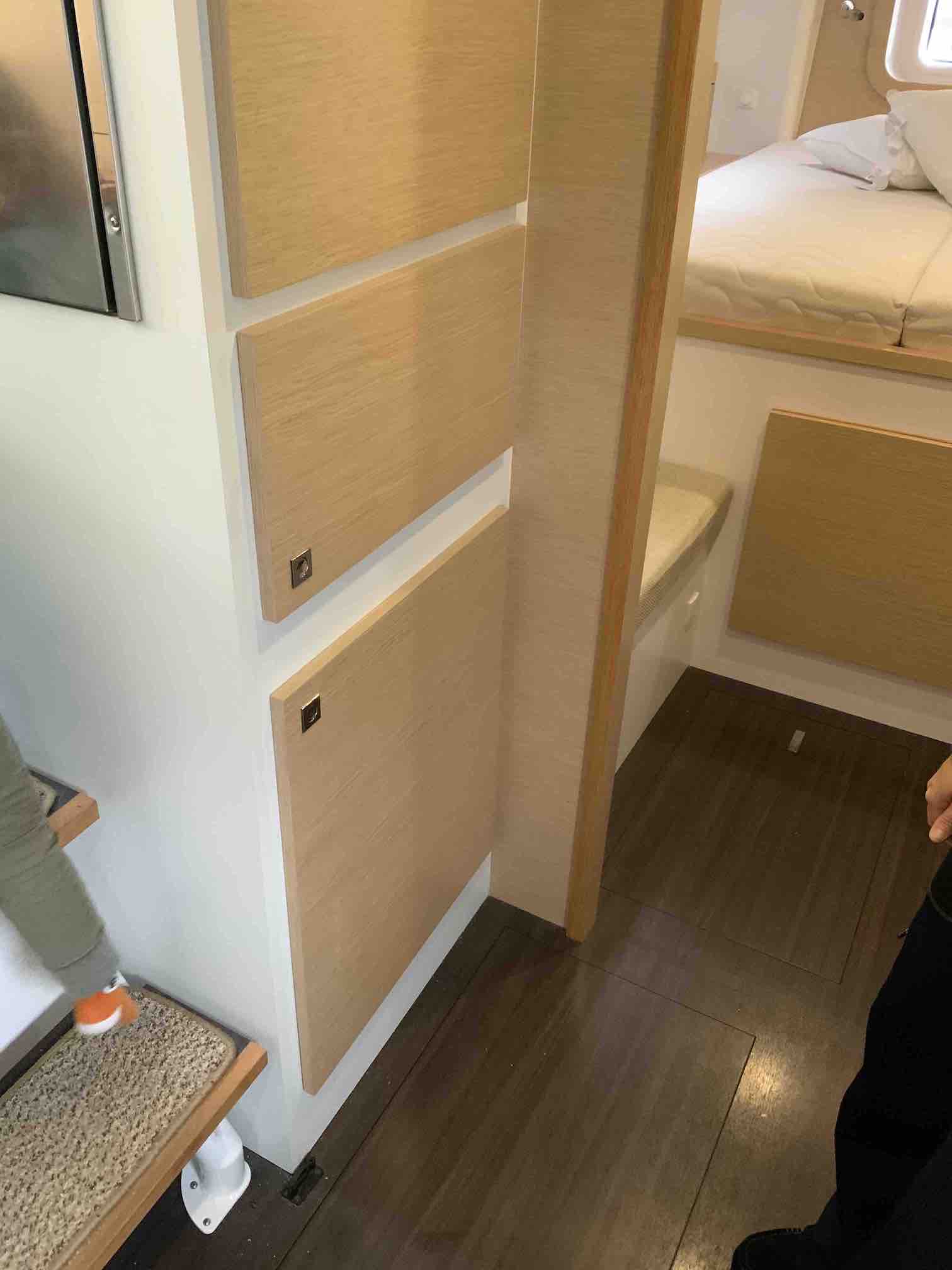
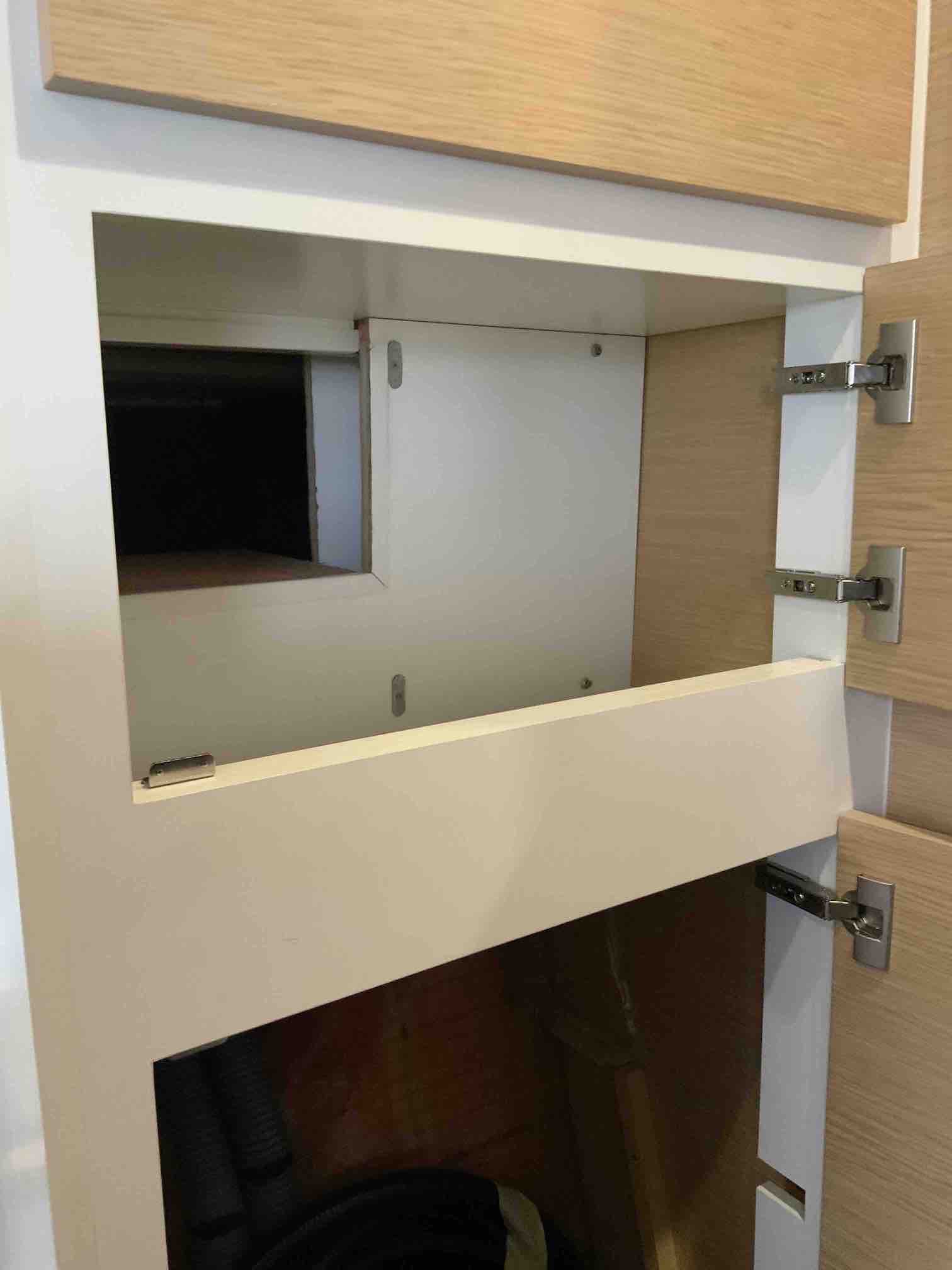
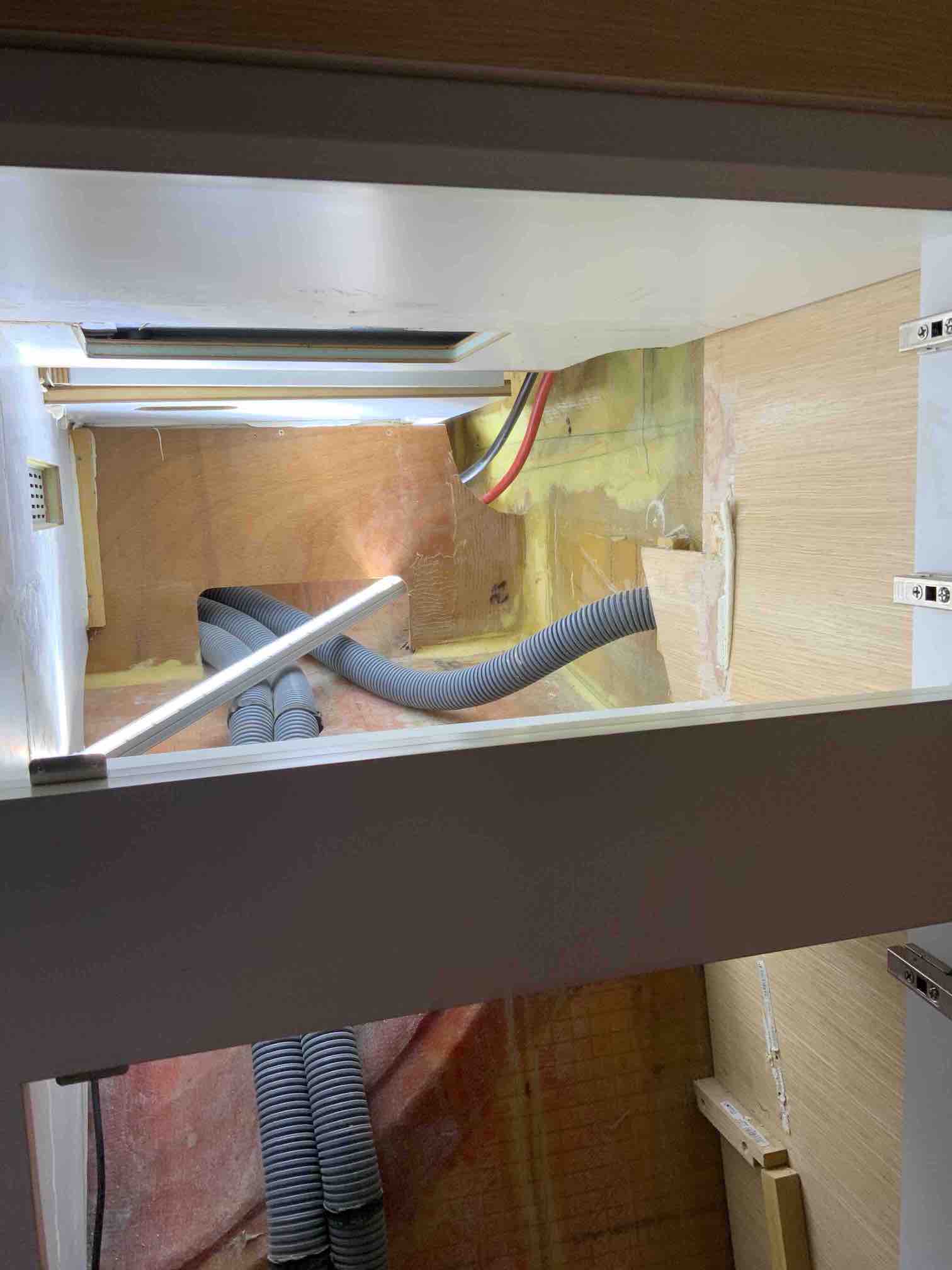
Modeling and Design
Building into this small hidey hole gave me a great excuse to test our new iPad Pro 3d scanning capability. I used the free version of the Polycam app for rough take off to determine whether the air conditioner would fit.

The initial results were encouraging, but the fit was tight. There wasn’t much more than 1/2” to spare. I had no idea what kind of precision the 3d scanner was giving me, so I opted to go to the next phase. I started a full measurement take off and built my own 3d model in Autodesk Fusion 360.

The original scan was a useful reference while building the Fusion model. Later I learned the pro version of Polycam allows for 3d mesh exports. Using that feature would have saved me a lot of time. I was (and still am) a Fusion 360 newbie. Modeling wiring, tubing and the various curves of the hull was non-trivial and a bit frustrating, but I got the hang of it eventually. The model was reasonably accurate and allowed me to determine placement and orientation of the air conditioning, the duct work, the plumbing and the wiring. Fusion comes with a free iOS app, which came in very handy. I was able to take off measurements from my model while on the boat. More importantly, I was able to show off the project to all of my friends.
The model confirmed the air conditioner would fit, but required an off angle orientation to make the fit work. A stringer would need to be cut back to make room for the 5” insulated duct. I would also need to buildup braces between the bridge deck and the shelf to support the 59 pound unit and to ensure the unit stays securely strapped down even in big pounding waves.
The installation required me to drill a 2” hole through a bulk head to allow me to plumb the waste seawater and condensate overboard. This hole made me more nervous than any other part of the project. It still makes me nervous. Drilling holes in critical structures should make me nervous. The best reference I could find on cruiser forums was from a Boeing engineer and at least one boat builder suggesting that one can drill holes at least one diameter from an edge. I’ve also heard anecdotally that bulk heads often only need the first three inches from the hull to do their job. What could go wrong making life-critical decisions using unverified Internet sources?
I drilled a 2” hole about 3” from the hull joint. I think the placement of the hole should be safe, but a few things make me uneasy. First, the same recommendations suggest that new holes should align relative to existing holes to preserve structural integrity of the bulk head. A bunch of holes all over the place is worse than if the holes are placed near by and properly aligned with each other. I wasn’t able to comply with that recommendation. I needed a slope from the air conditioner condensate collection pan on one side of the bulkhead to the scupper through-holes on the other side of the bulkhead to ensure water drains without needing a pump. The hole location wasn’t near by the existing holes, so I was punching another hole willy nilly in my critical bulk head. Second, catamaran’s are different than monohulls. Their bridge deck bulkheads aren’t just holding the hulls against water like a monohull, they are also holding the hulls together. Is hole placement guidance the same? Are catamaran bulkheads doing more than just preventing buckling and does that change hole-making guidance? Probably. I’m also told that the loads from the main sail are significant. This particular bulk head is nearest to the chain plates for the stays holding the mast up and carry much of the sail loads.
I drilled the hole and discovered the third thing that makes me nervous. After drilling, I examined the plug from the hole saw which let me inspect the fiber glass layup and the foam core of the bulk head. At first, I saw that fiber glass thickness was pretty thin, maybe 1 mm. That’s a good sign, thin glass indicates the section is not carrying a lot of load. But then I saw the bottom of the plug, the bit that was closest to the hull. That bit was quite a bit thicker, perhaps 3 or 4 mm. I had cut about 10 mm into something that was built up and probably is carrying higher loads. Ugh. Well its done now, and I’ll inspect it for any cracking as we sail.
Shelf
I needed something strong and reasonably light for the shelf. I wanted additional support in the middle of the shelf, since the span between the cabinet walls was almost 24”. I also needed a way to secure the shelf to the boat to give the air conditioner a strong hold down to prevent it from flying around in rough seas.
I tried to match existing boat materials as best I could. Most of the plywood on the boat seems to be Okoume. Okoume isn’t off the shelf plywood, it is grown in Africa and manufactured in France. Fortunately, it wasn’t difficult to source for us. The Seattle area has a lot of boat builders, and Port Townsend has a lot of wooden boat builders. Okuome is a popular choice of plywood and was available at Edensaw out of Port Townsend. To build up supports off of the bridge deck, I preferred composite foam to wood. I wanted something easier to shape than plywood and something that doesn’t mind getting wet. My friend recommended Coosa board, a product from a local manufacturer that is a lighter drop in replacement for anything you might use plywood for.
The Coosa board was pretty easy to work with. I built three blocks using 3/4” Coosa board. The tallest block was 6 layers thick. The shorter blocks were 3 layers thick. I cut the Coosa into 4” squares using a track saw and a chop saw. Then I laminated the pieces, placing a piece of chop strand fiberglass between the blocks with a wet layup of vinylester resin. I gave ‘em the clamps and let them cure. I cleaned up the squeeze out using the chop saw and rounded over the corners with a sander. After a couple hours of work, the blocks were ready for final fitting and cutting while on the boat.

The shelf was straight forward for dimensional cuts and cut outs, no need for funny angles to fit the space. I used a router to round over the edges any place where wires or tubes were likely to run. Then I sanded everything to 180 grit. Now it was time to do a real fiberglass layup, my first real layup. It got a little ugly. I mixed up my batch, which in retrospect was probably too hot a mix given the high summer temperatures and the direct sunlight. I saturated the plywood with resin, and then attempted to layout the pre-cut fiberglass. The moment the glass touched to resin, it stuck and didn’t really want to move. Yikes. I did the best I could with alignment, but left a bit of plywood without fiberglass coverage. Then I did the dance of the fiberglass layup, quickly trying to work out all of the airbubbles with my foam roller. It turns out I didn’t have proper rolling tools to get the air bubbles out. I didn’t know better at the time. The final result was ok. There were streaks of micro air bubbles, but nothing too terrible. It was all getting a coat of epoxy paint anyway.
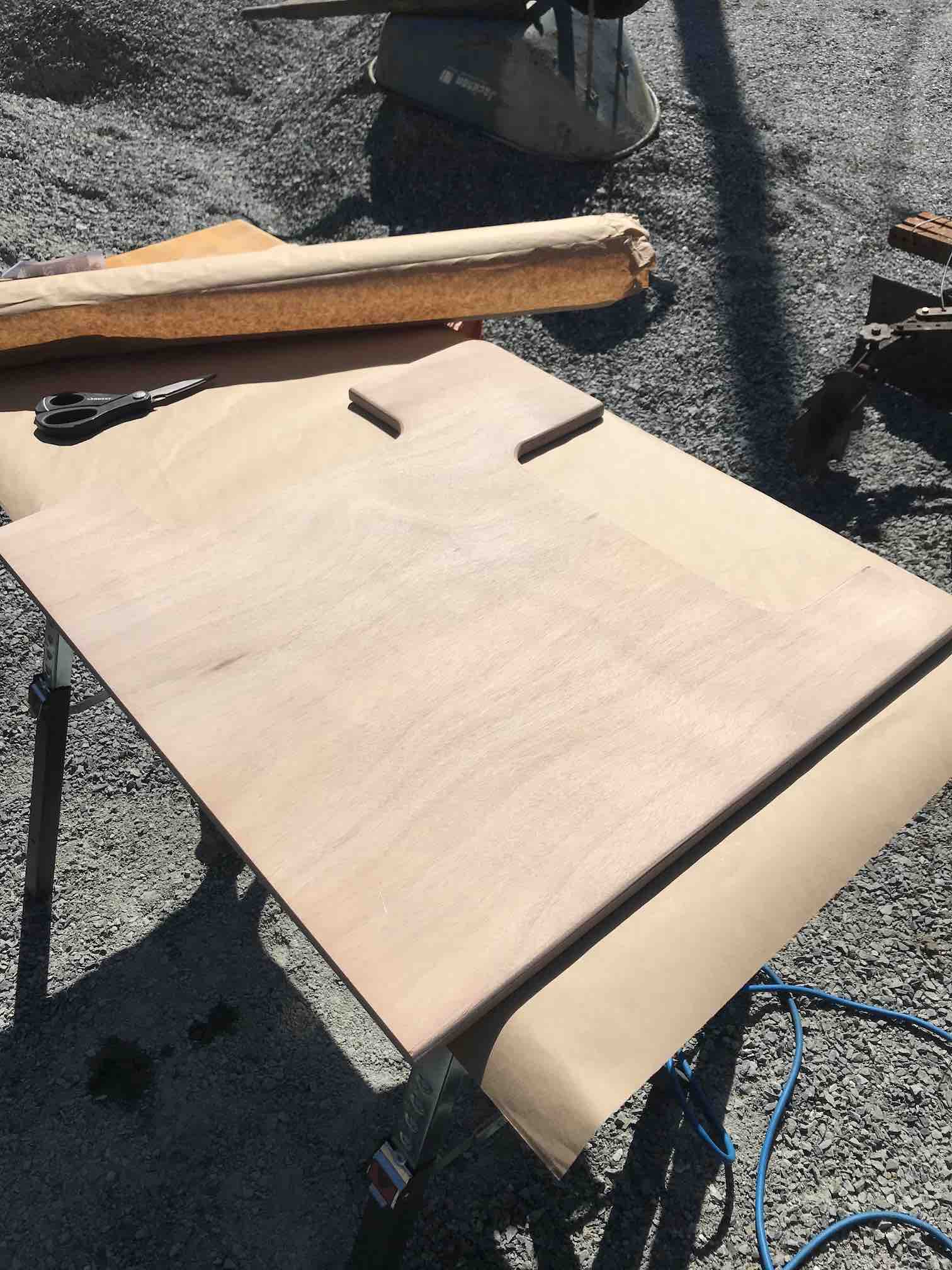
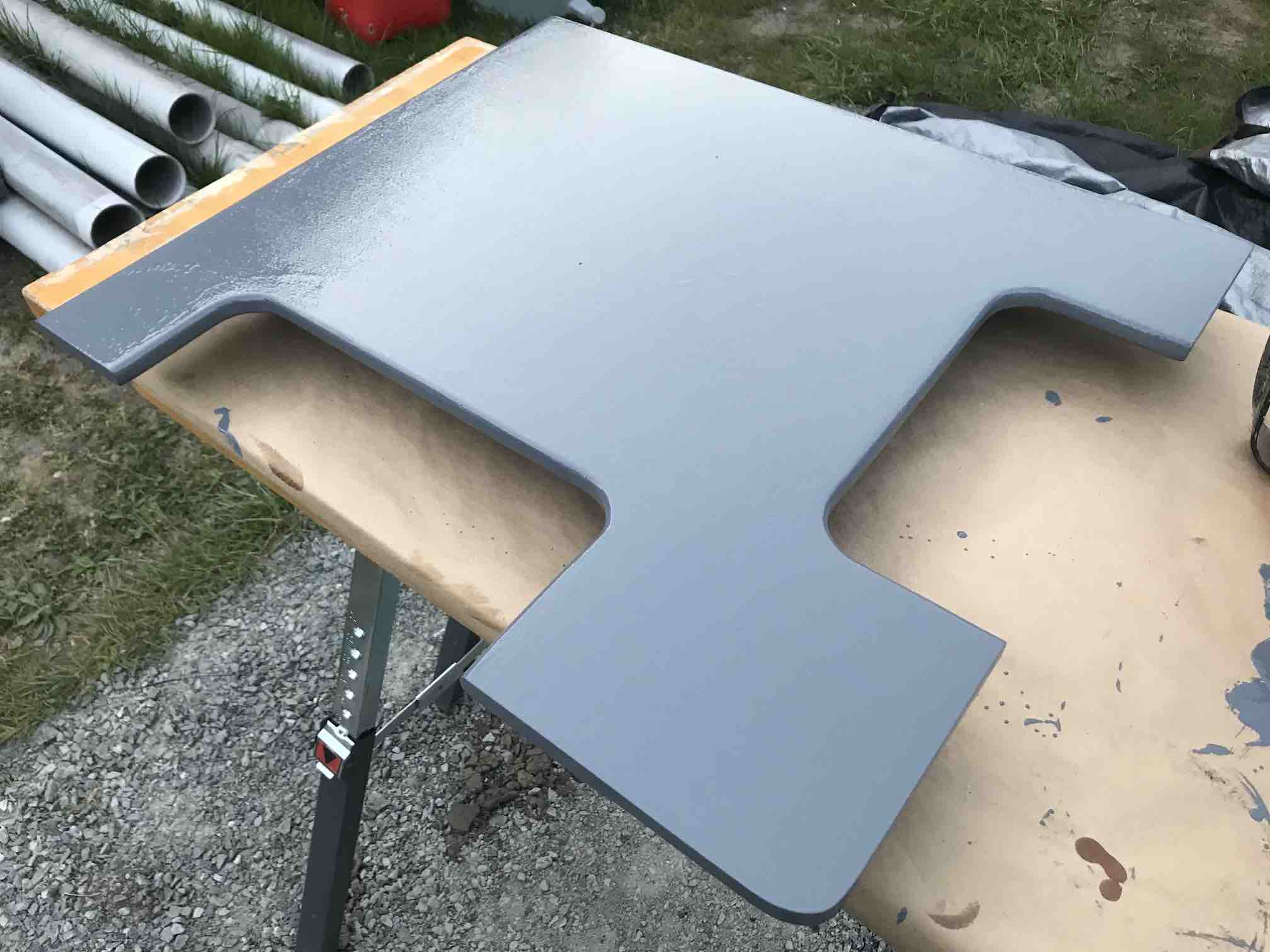
With the blocks and the shelf complete, it was time for fitting and installation. I used a laser level to mark out the shelf perimeter, and screwed ledgers into the perimeter of the cabinet where where I could. I set the blocks in their positions and used a sharpie to marked out the laser line and then I traced their position on the bridge deck hull. The blocks themselves were at an angle, because the bridge deck hull was sloped. This meant the laser bisected top of each of the coosa blocks at a funny angle. I used Jiggly Puff, my occilating multi-tool, as my cutting tool of choice here. A bandsaw would have been ideal, but you work with what you got. With each block cut, I placed them in their positions, then put the shelf in to check the fit of the blocks and the ledger.
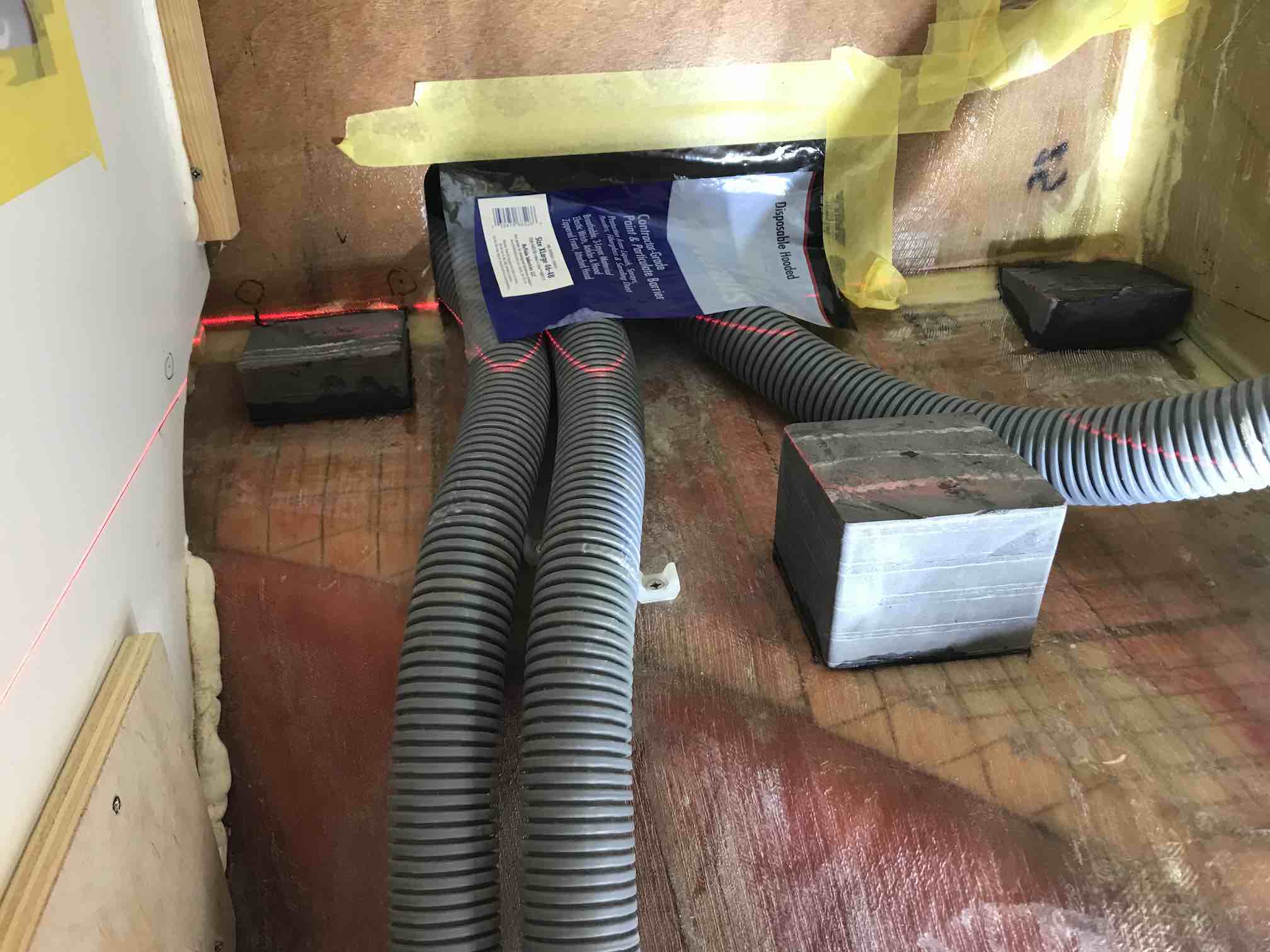
Everything looked good, so drilled and countersunk holes that would be used to screw the shelf to the ledger and the shelf to the Coosa blocks. Each of those holes was then filled with resin, left to cure and redrilled to protect against water ingress. The Coosa blocks were bonded to the bridge deck hull with resin and a layer of chop strand. Then I spread a fillet of structural resin around the perimeter any where the Coosa block touched hull, cabinet wall or stringer. Writing this, it all sounds nice and simple, but the schedule of all of this took day and days. It was a pain, but I wanted to do this part right. I didn’t want this expensive machine slamming around in heavy seas, and I didn’t want water to rot days and days of effort.
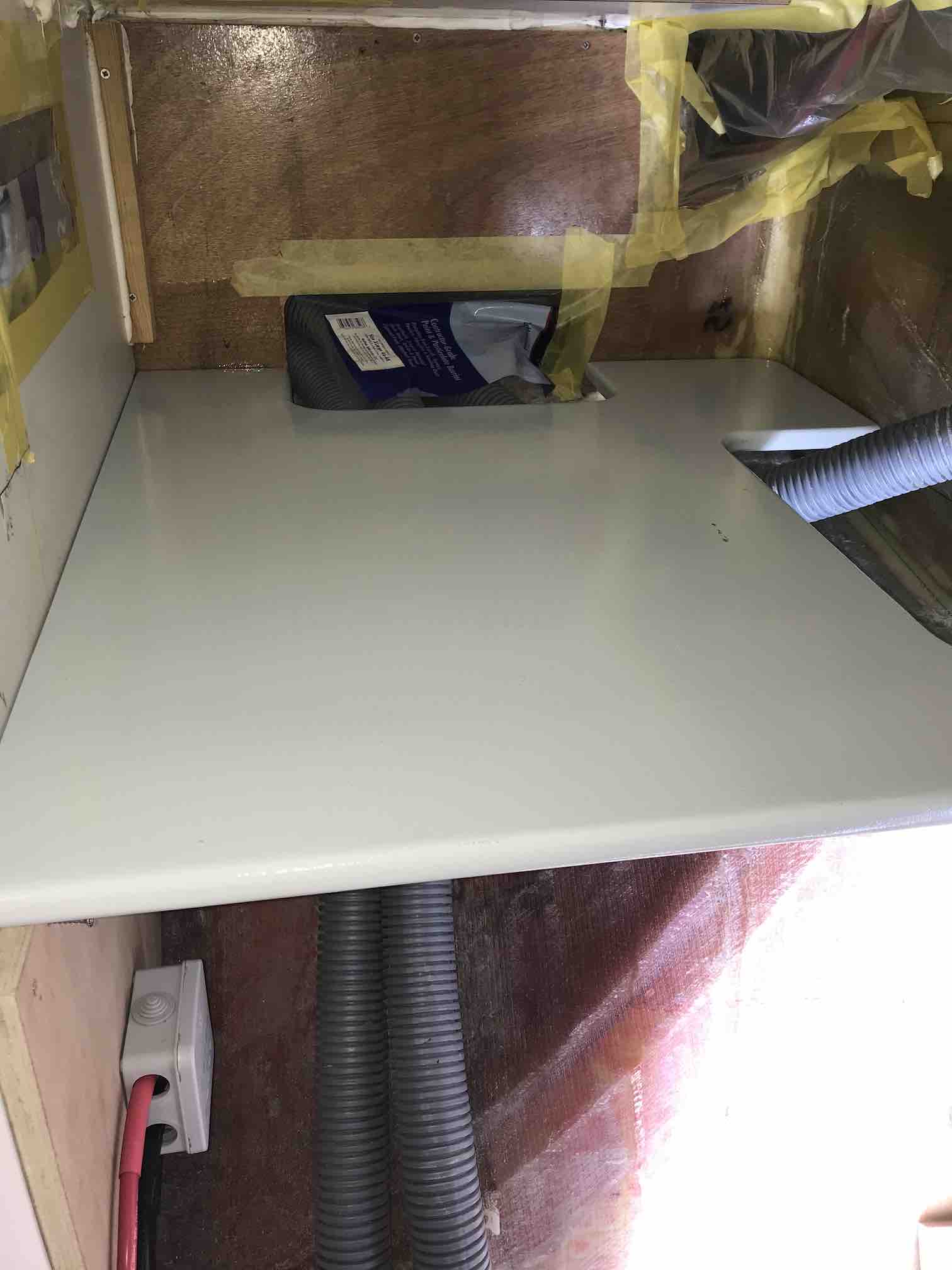
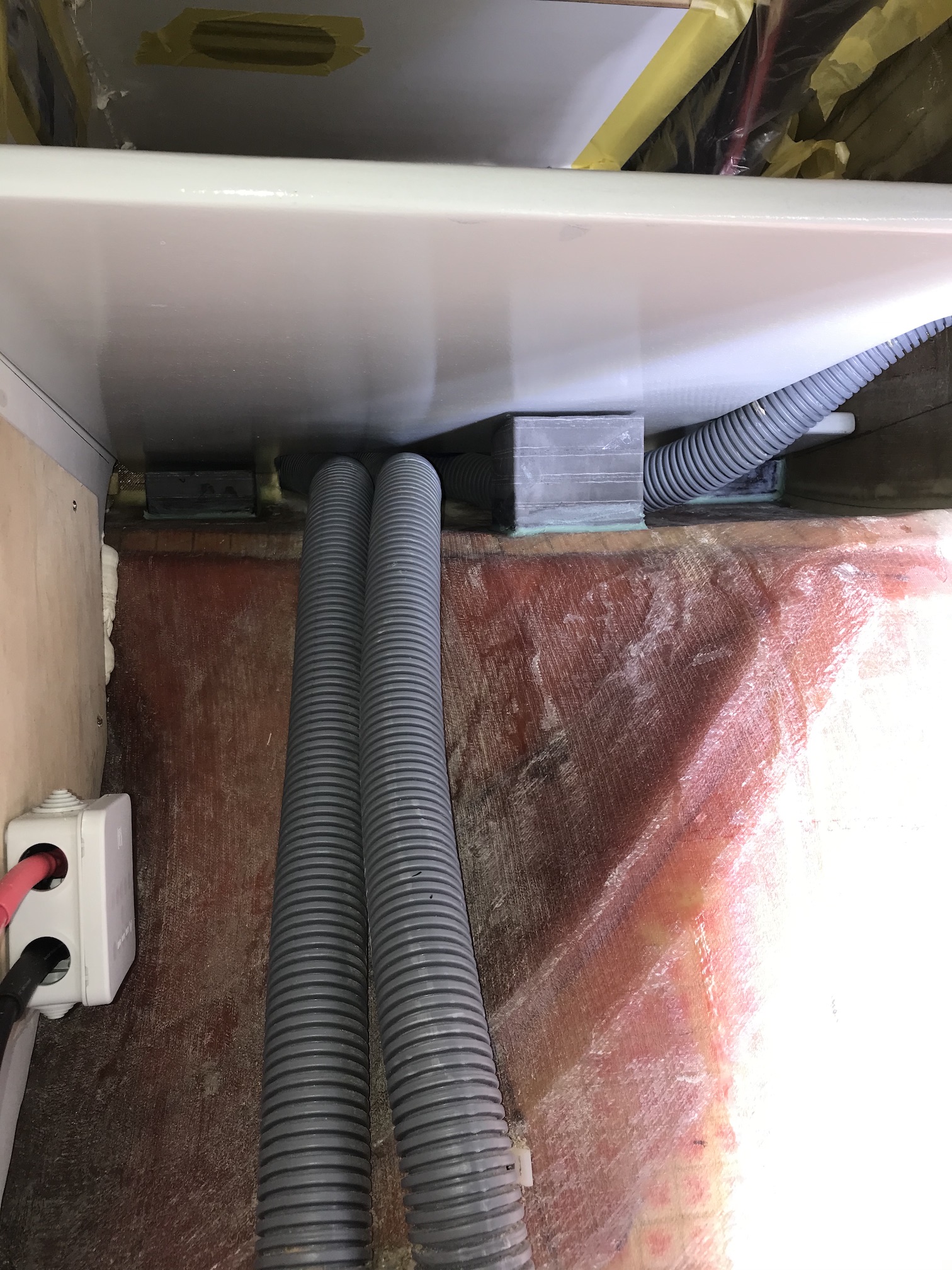
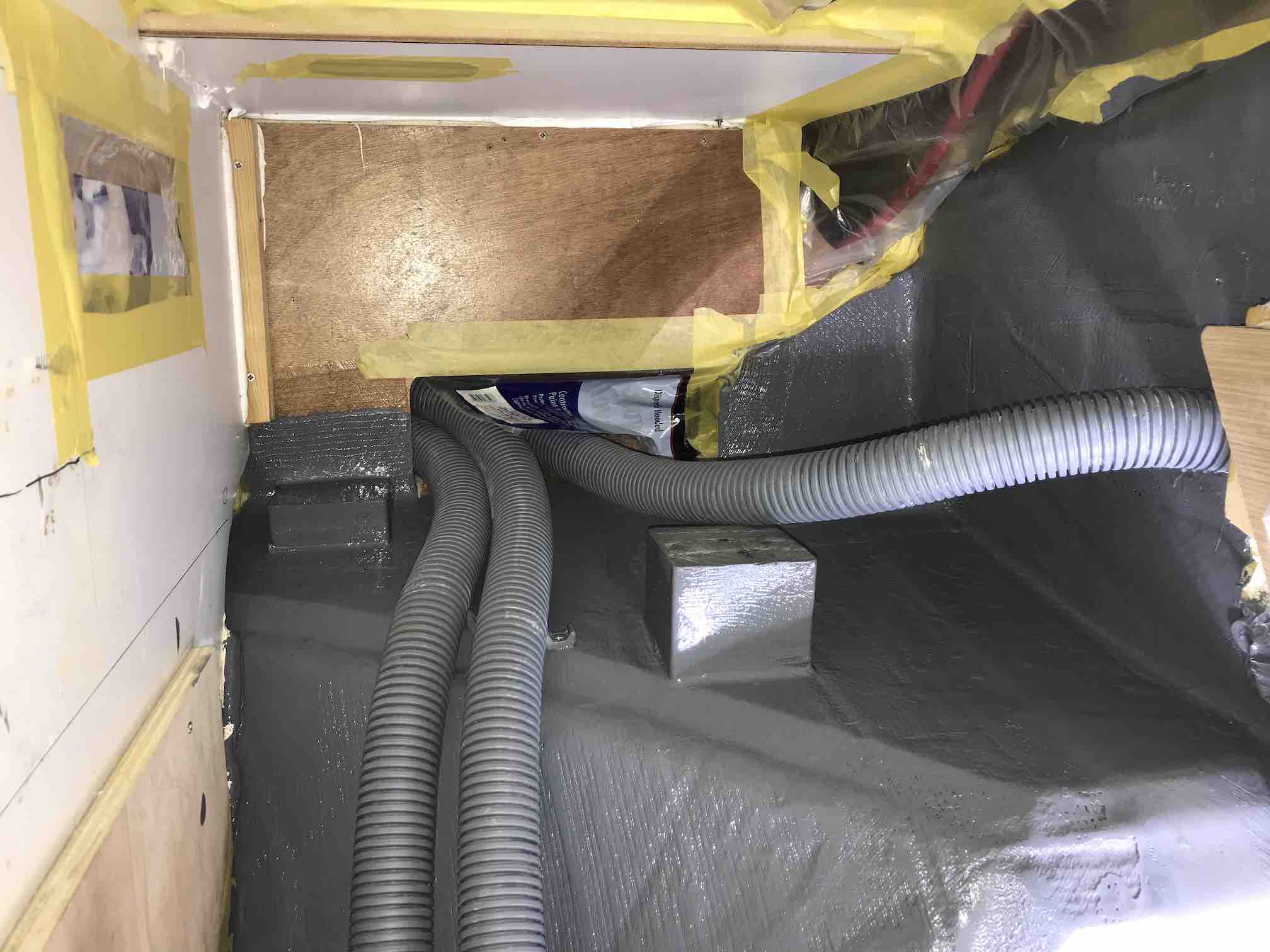
Electric
I needed help with the electric runs, so I called my dad to help. He’s pulled a few miles of cable in his day, he knows a few tricks of the trade.
Working on the Outremer is quite nice, Spice had conduit where we needed it with enough room to accommodate rather large 4AWG cables. The pull wasn’t too challenging and was done in a couple of hours. The terminations were big, and of course they required a new tool. I purchased a set of lugs to terminate the cable with fittings that could mount to stud bolts, but didn’t quite get the right stud-hole size. It seems that all projects require at least one run to the hardware store. In our case, we headed to WestMarine in Bremerton to get marine-grade terminals.
Once back on the boat, we installed the 60 amp breaker on the massive bus-bars in the main electric area near the battery bank. For the other end of the cable in the hidey-hole, we built an Okoume backer-board to mount the junction box containing the studs that would connect the cable run to the air conditioner wiring. We mounted the backer board to the wall with 3M 4200 and a few screws. Then we screwed the terminal box and terminal studs to the box and backer board. With the terminals at either end installed, we did the final cable routing, cut the cables, sleeved the cable with marine-grade heat shrink and crimped on the lugs. After taking the heat gun to the heatshrink, we mounted the cables to the terminals on either end. We had our high-amperage cable run.
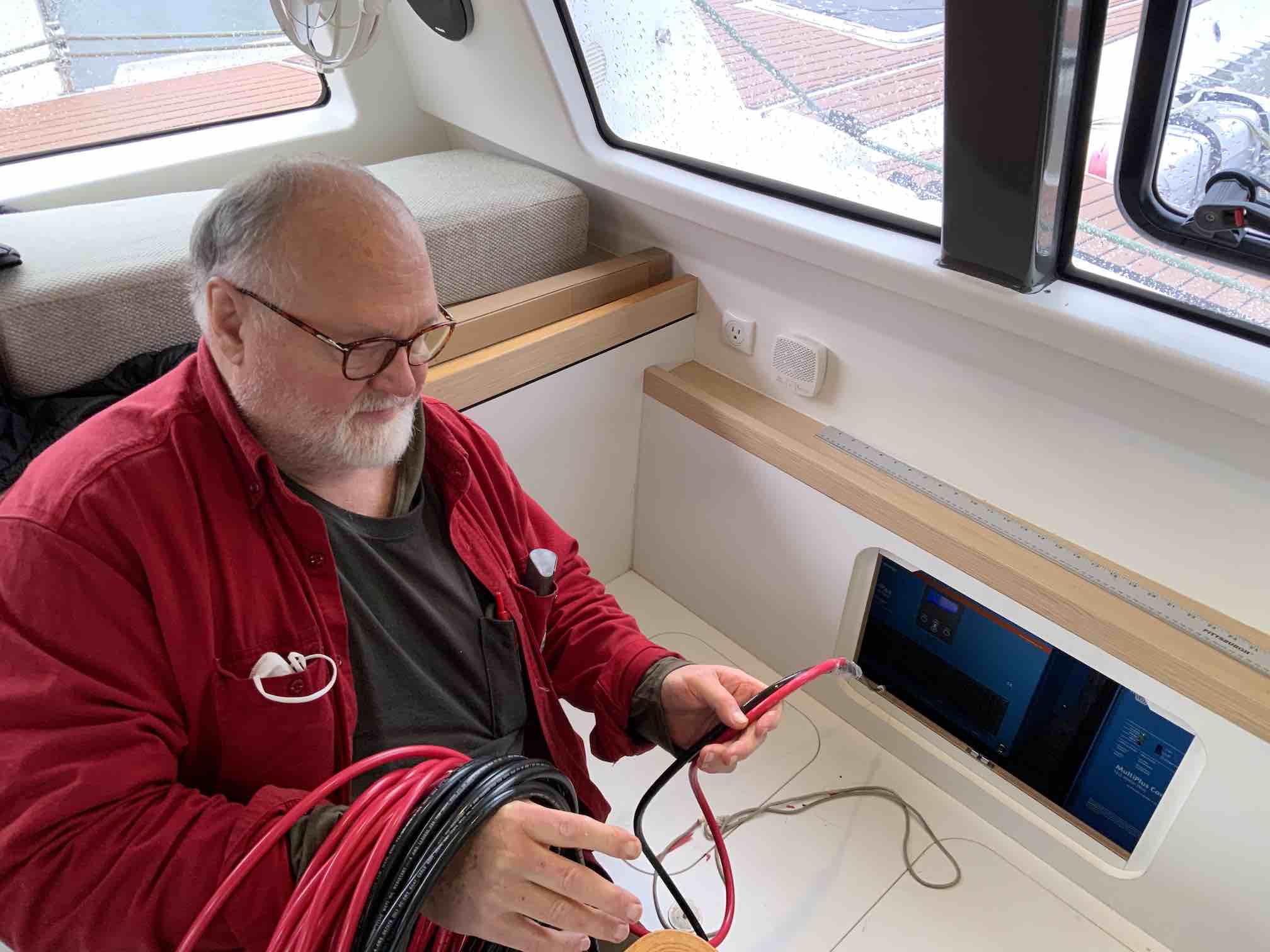
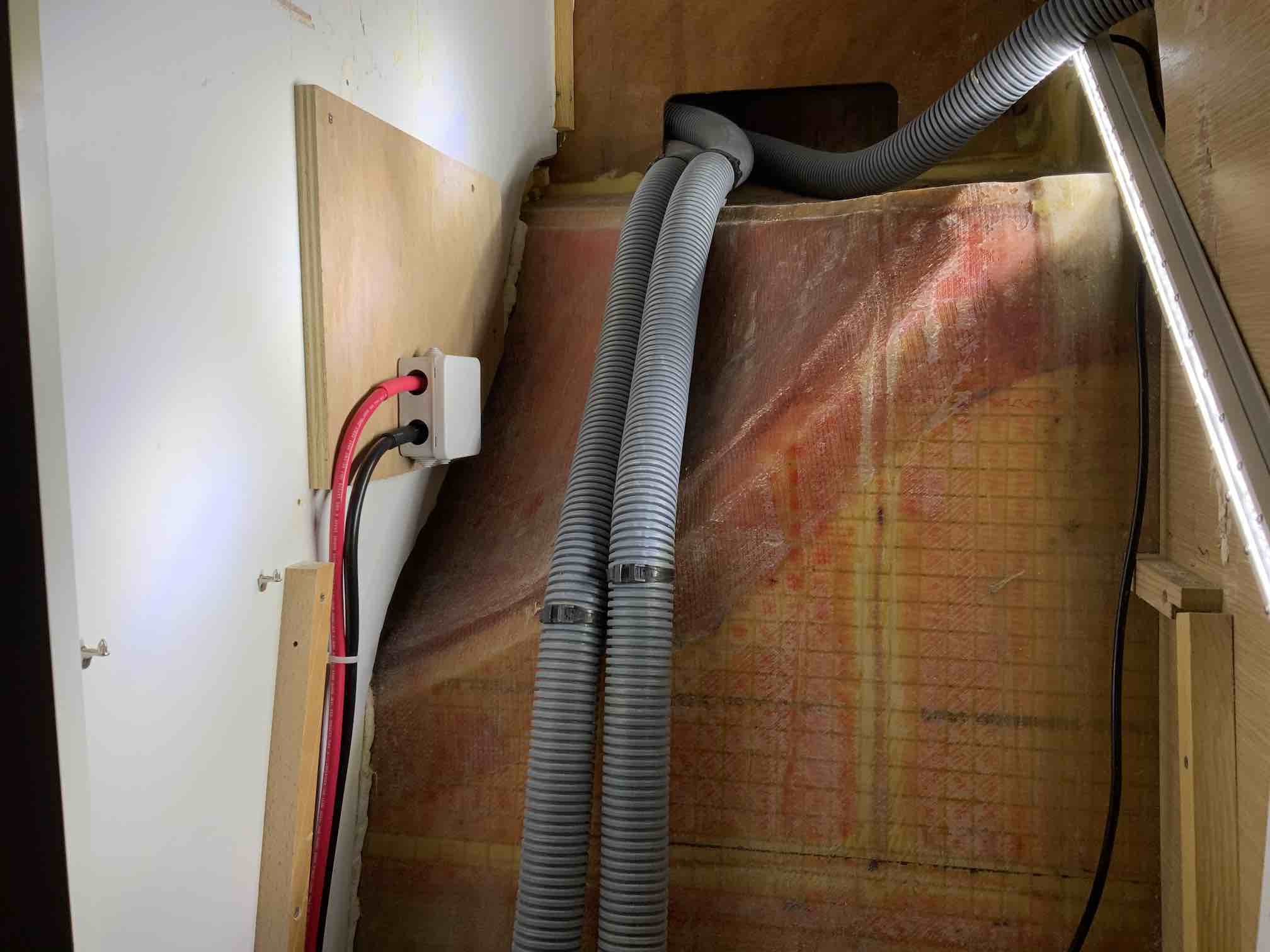
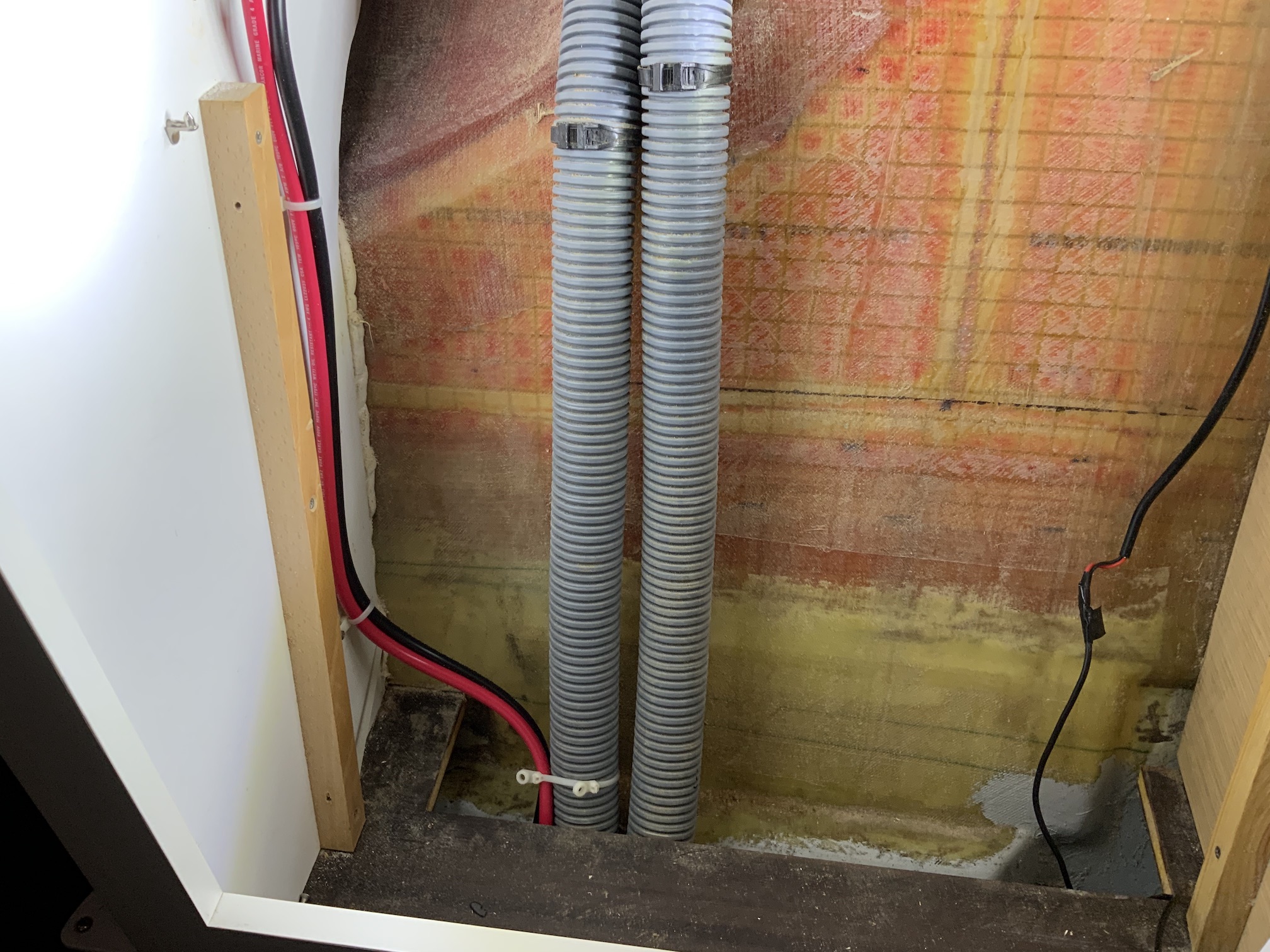
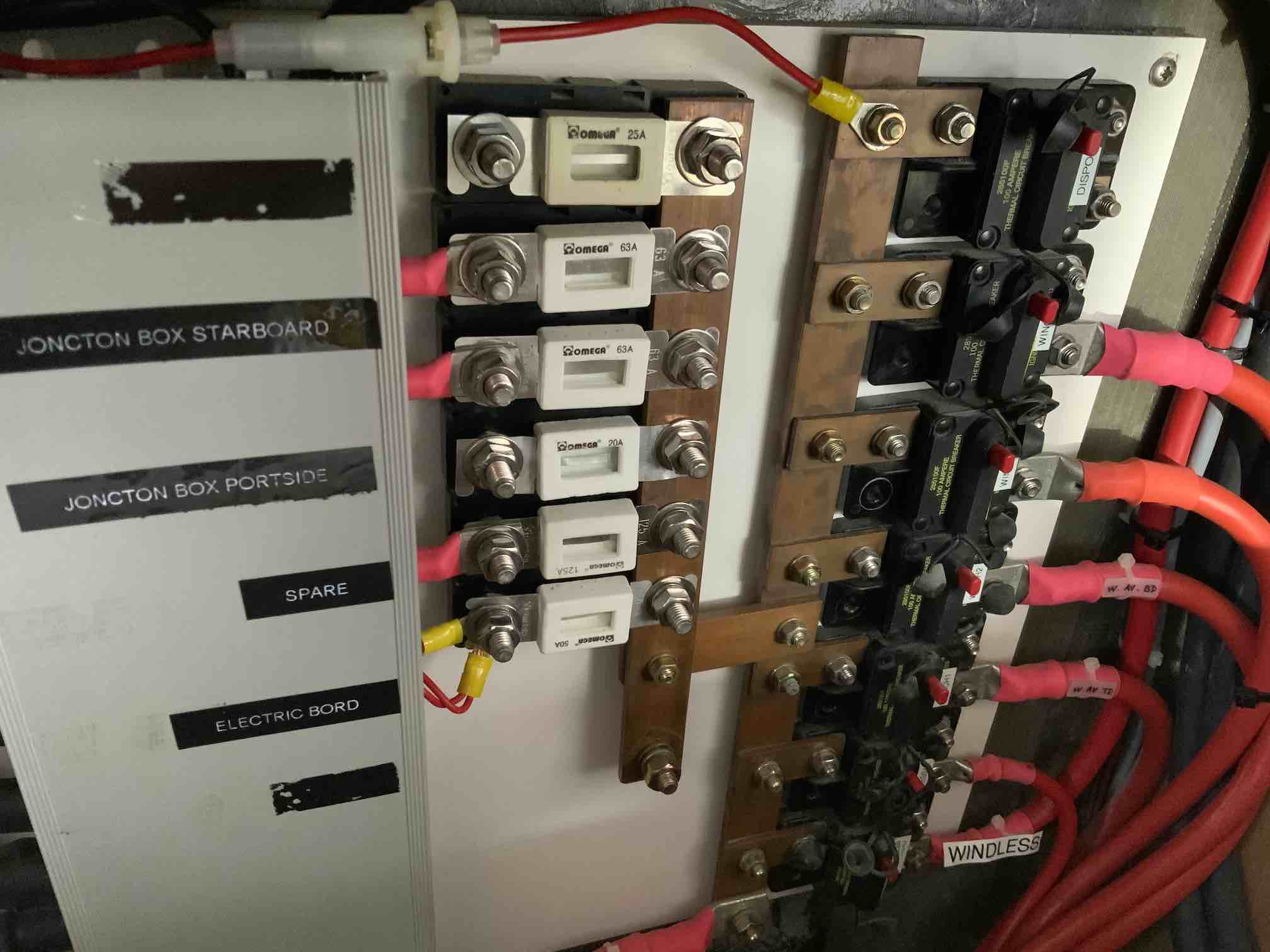
Pump & Plumbing
The plumbing was a bit of a trial. I thought it would be easy. The air conditioner comes with a cute little pump. After much cursing and many stripped screws, I mounted the pump and a new raw water strainer in the bilge near one of the existing through holes. I teed be off of the existing raw water hoses. I ran the hoses into the air conditioner cabinet, then ran a hose through the structural bulkhead via the hole-of-everlasting-anxiety and teed into a scupper hose to drain out the through hull.
It was time to hook up the air conditioner for a test. I wired in the pump and connected the air conditioner to the main terminals. Then I turned on the air conditioner for the first time. The little water pump started whirring, but no water was flowing. Then the compressor started and ran for a while, but it eventually got too hot and went into alarm.
If you’ve ever worked with barbed hose fittings you might know how difficult it is to remove them. Often times you can’t remove them and just have to cut the hose. Well I ended up doing that about ten times as I tried to troubleshoot the problem with the pump. The pump needs to be primed, and it was, but there was some air in the system I thought might be the problem. After 3 or 4 attempts at trying to bleed out the air with no improvement, I switched to trying to suck water through the air condition unit. Sea water was getting everywhere. I finally concluded that either the pump was broken, or more likely, it was underpowered for the size of hose and the length and height of the run. I changed it out for a larger pump, and we were in business.
Ductwork
Our installation needed one return vent, and two output vents. The main output run connected a 5”insulated duct to a vent in the salon under the galley table. This duct ran inboard from the air conditioner. Then it took a left turn toward the forward part of the boat. The duct then ran through a plenum under the salon floor along the bridge deck joint for about 5 feet. I cut a large hole in the floor of the salon inside the cabinet of the settee. Then I cut a rectangular vent hole under the settee and out into the salon. The other outlet uses a 3 inch duct that wye’s off of the 5 inch duct in the hidey-hole and does a u-turn back into the air conditioner cabinet. From there it runs down the hull into the bilge, turns aft and goes through a bulk head under the floor. No need to cut a hole, I reused one that was there. At this point the 3 inch duct transitions to ABS pipe. The pipe continues aft for 3 feet, then turns upward into a hole cut in the floor within the cabinet in the master cabin. The pipe continues to about head height where it exits the wardrobe cabinet in a 3” round vent, right under a cabin fan.

Running all of this duct work and getting it properly insulated was another multi-day ordeal. This also involved many trips to the hardware store. Joining all of the duct involved installing hose clamps in hard to reach places, and splicing duct together with an improvised plastic wire-tie suture. Of course duct tape was used with reckless abandon.
Running the 5 inch duct required enlarging a hole in a stringer at the inboard end of the air conditioner cabinet. I cut this hole using a jig saw. This would have been straightforward, except that I had to push my recently embiggened covid-bod through a small square hole. Then I had to wield a cutty shaky thing whilst surrounded by itchy fiber glass. But I got it done, and the hole looked reasonably clean in the end.
Final Installation
The last remaining bits of install included applying the epoxy paint to all exposed hull in the air conditioner cabinet. Then I installed the shelf for the last time. The pan of the air conditioner needed through-bolts in the shelf for the hold-down hardware, which involved yet another drill, resin, drill sequence. I had to cut foam to block off air flow between the bilge and bridge deck and the air conditioner compartment to prevent any cold air or bildge air from flowing into the inlet. And finally, I had to rebuild the cabinet shelves.
How does it work? It works well. The unit managed to raise the temperature of the salon from 42 degrees to 59 degrees in less than 1 hour, and it keeps the space comfortable. The unit is pretty quiet. However, it is quite a bit different than the electric element heaters or diesel heaters. The electric element heaters output hot air, diesel heaters can even emit positively scalding air. The Mabru air conditioner emits warm air. It isn’t an apples to apples comparison. The electric heaters draw 900 watts to 1200 watts, whereas the Mabru is pulling 500W or less. In the end, I think this was the right choice relative to our other options. Now we have a diesel-free air conditioner or heater whenever we need it.
